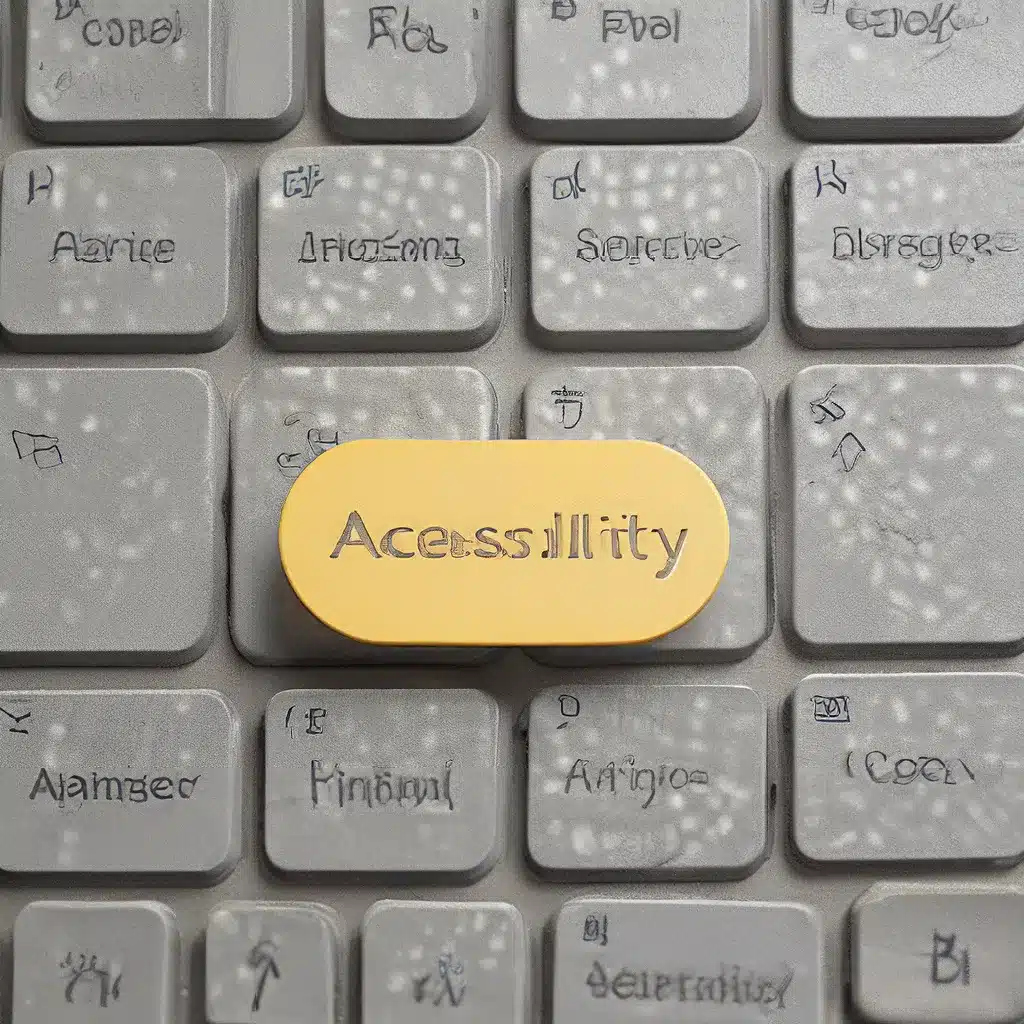
The Importance of Accessible Web Design
When it comes to creating successful websites, two crucial factors often go hand-in-hand: accessibility and search engine positioning. Accessible web design ensures that users with diverse needs, including those with disabilities, can effectively engage with and navigate your online content. This not only aligns with ethical principles of inclusivity but also has a direct impact on your website’s search engine optimization (SEO).
Accessibility is not merely a box to be ticked; it’s a foundational element of modern web development. By prioritizing accessibility from the outset, you can create user-friendly experiences that cater to a wider audience and boost your online visibility. When a website is designed with accessibility in mind, it becomes more search engine-friendly, as search engines often prioritize content that is easily accessible and understandable.
Research has shown that accessible websites tend to have higher search engine rankings, as search engines favor content that is easy to crawl, index, and understand. This mutually beneficial relationship between accessibility and search engine positioning is crucial for any business or organization looking to establish a strong online presence and reach their target audience effectively.
Principles of Accessible Web Design
At the core of accessible web design are a set of guiding principles that aim to ensure equal access and usability for all users, regardless of their abilities or assistive technologies they may use. These principles, often referred to as the Web Content Accessibility Guidelines (WCAG), include:
- Perceivability: Ensuring that the content and interface elements are presented in a way that users can readily perceive them, whether through visual, auditory, or other sensory means.
- Operability: Designing interactions and navigation that are operable and intuitive, allowing users to effectively navigate and interact with the website using various input methods, such as keyboard, mouse, or voice commands.
- Understandability: Crafting content and functionality that are easily understandable by users, including clear language, logical organization, and intuitive user interactions.
- Robustness: Ensuring that the website is compatible with a wide range of user agents, including various web browsers, assistive technologies, and emerging technologies, to provide a consistent and reliable experience.
By adhering to these principles, web designers and developers can create websites that are accessible to the widest possible audience, including users with visual, auditory, motor, or cognitive impairments.
The Impact of Accessibility on Search Engine Positioning
The connection between accessible web design and search engine positioning is rooted in the fundamental goals of both.
Search engines strive to provide users with the most relevant, high-quality, and accessible content. When a website is designed with accessibility in mind, it often aligns with the search engines’ own criteria for ranking and indexing web pages. Some of the key ways in which accessible web design can boost a website’s search engine positioning include:
- Improved crawlability and indexability: Accessible websites often have well-structured content, clear navigation, and semantic markup, making it easier for search engines to crawl, index, and understand the website’s content.
- Enhanced user experience: Accessible websites provide a seamless and inclusive user experience, which can lead to increased time on site, lower bounce rates, and higher engagement metrics – all of which are important signals for search engines.
- Content accessibility and relevance: When content is easily accessible and understandable to users with diverse needs, it becomes more relevant and valuable to search engines, leading to higher rankings.
- Compliance with search engine guidelines: Many search engines, such as Google, have published accessibility guidelines that align with the WCAG principles, encouraging website owners to prioritize accessibility as part of their SEO strategy.
By embracing accessible web design, businesses and organizations can not only improve the user experience for their customers but also enhance their search engine positioning, making their websites more discoverable and prominent in search engine results.
Strategies for Integrating Accessibility and SEO
Integrating accessibility and SEO requires a holistic approach that considers the needs of both users and search engines. Here are some strategies to help you achieve this:
- Conduct accessibility audits: Regularly assess your website’s accessibility using tools and guidelines, such as the WCAG, to identify and address any issues.
- Optimize for semantic markup: Utilize semantic HTML elements and ARIA (Accessible Rich Internet Applications) attributes to provide clear structure and meaning to your website’s content, making it more accessible and search engine-friendly.
- Ensure alt text for images: Provide descriptive alt text for all images and visual elements on your website, which not only helps users with visual impairments but also allows search engines to better understand the content.
- Prioritize clear and concise content: Write clear, concise, and easy-to-understand content that can be effectively consumed by users with diverse needs and efficiently indexed by search engines.
- Optimize for mobile accessibility: Ensure your website is responsive and mobile-friendly, as search engines often prioritize mobile-optimized content and user experiences.
- Implement keyboard-accessible navigation: Ensure your website’s navigation and interactions can be easily accessed and operated using a keyboard, catering to users with motor impairments and aligning with search engine guidelines.
- Provide accessible multimedia: If your website includes audio or video content, provide transcripts, captions, and audio descriptions to make it accessible to users with hearing or visual impairments, while also making the content more searchable.
- Collaborate with accessibility experts: Engage with accessibility specialists who can provide guidance and expertise in implementing effective accessibility solutions that also support your SEO efforts.
By adopting these strategies, you can create a synergistic relationship between accessibility and search engine positioning, ensuring that your website not only provides an inclusive user experience but also achieves higher visibility and discoverability in search engine results.
The Future of Accessible Web Design and SEO
As the digital landscape continues to evolve, the importance of accessible web design and its integration with search engine positioning is only expected to grow. Several emerging trends and considerations highlight the increasingly crucial role of this relationship:
- Increased focus on user experience: Search engines are placing greater emphasis on user experience as a ranking factor, rewarding websites that provide seamless and inclusive experiences for all users.
- Rise of voice search and assistive technologies: The widespread adoption of voice assistants and other emerging technologies requires websites to be designed with accessibility in mind, as these technologies rely on clear, structured, and easily consumable content.
- Regulatory compliance: Many countries and regions are implementing laws and regulations that mandate accessibility standards for websites, making it a crucial compliance requirement for businesses and organizations.
- Evolving search engine algorithms: Search engines are continuously refining their algorithms to better understand and prioritize accessible and user-friendly content, further strengthening the symbiotic relationship between accessibility and SEO.
- Inclusive design as a competitive advantage: Businesses that embrace accessible web design and integrate it with their SEO strategies can gain a competitive edge by reaching a wider audience, improving customer satisfaction, and enhancing their online visibility.
As the digital landscape continues to evolve, the successful integration of accessible web design and search engine positioning will be a key driver of success for businesses and organizations seeking to establish a strong online presence and reach their target audience effectively.
Conclusion
In the dynamic world of web development, the relationship between accessible web design and search engine positioning is increasingly crucial. By prioritizing accessibility from the outset, businesses and organizations can create user-friendly experiences that cater to a wider audience and boost their online visibility through enhanced search engine rankings.
Through the implementation of accessible design principles, web developers can ensure that their websites are not only inclusive and easy to navigate but also search engine-friendly, leading to improved crawlability, indexability, and content relevance. This mutually beneficial relationship is a strategic imperative for any organization looking to establish a strong online presence and reach their target audience effectively.
As the digital landscape continues to evolve, the integration of accessibility and SEO will only become more critical. By staying ahead of the curve and embracing the synergistic potential of these two key elements, businesses can future-proof their online presence, create inclusive and engaging user experiences, and maximize their visibility and discoverability in search engine results.
Stronyinternetowe.uk is dedicated to providing comprehensive web development services that seamlessly integrate accessibility and search engine optimization, empowering businesses to thrive in the digital landscape. Contact us today to learn more about how we can help you harness the power of this mutually beneficial relationship.




